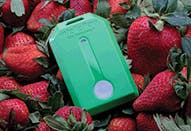The concept of "bring your own device" has expanded to "be your own device."
It might be a slight stretch of the definition of what is a device, but at least one group has very publically and controversially started offering an option for people to have an RFID chip inserted under their skin. At the heart of Sweden's tech community, Epicenter is an office building where people and technology literally merge—at least, when it comes to radio frequency identification (RFID) technology.
In a widely reported event, Patrick Mesterton, co-founder and CEO of Epicenter, discussed the option for workers to have RFID chips inserted under the skin of their hand. With the chip inserted and the worker's identity registered, basically, anywhere the worker would have used an identification badge to gain access, they could now hold out their hand for a scan.
The technology (and even the application) is not new, but this event will certainly reignite discussions about privacy.
In distribution centers and retail stores where RFID is not uncommon, some of the values and limitations of the technology are well understood. RFID is viewed as a tool that can help address productivity and security issues.
Most applications of RFID technology use passive tags that do not give up data until asked. The query comes in the form of a radio signal that polls the chips and "excites" a response. Similar to a bar code where the black and white surfaces of the bar code reflect or don't reflect back to the reader, the signal the reader collects provides an identifier when interrogated which can be associated with a database to provide more information about the item being scanned. In the simplest form, the identifier equates to alphanumeric characters that provide a human-readable output. In other words, the bar code or RFID label simply repeats what is already printed on the label.
As with most computer-based technologies, the capacity of the codes has expanded. The technology is not constrained to using a "license plate" identifier which must be used to look up information in a database; now whole paragraphs or documents can be encoded in the small space of a label.
In application, RFID tags can carry more data about the product they are attached to. This can be merely a product identifier—a proprietary product or stock keeping unit (SKU) number. Or, the electronic label can include the product number, serial number, manufacturing or processing date and location, lot number, expiration date, etc. The implications for product tracking are significant.
Added Security
Asset Intelligence reported that in one quarter cargo theft increased by 5% and average stolen load value increased by 9%. Between June and August 2013, the company said, 202 cargo thefts were reported, with an average loss value per theft of $166,454. Securing the supply chain may be the first goal, but when a loss occurs, tracking stolen items can reduce the potential for further losses.
One area where high-end electronics retailers have been using the capabilities of automatic identification more completely is with returns and warranty repairs. Using visible bar code labels or embedded RFID tags, a quick scan can match the product to the purchase record. If the item does not match the purchase record, the company can take appropriate action—declining warranty service if it is not the item covered by the warranty or seizing the item if it has previously been reported stolen.
Getting Personal
Data accuracy and integrity are a major concern for many manufacturers, and the amount of specificity that automatic identification technologies can provide is a value shared by bar codes and RFID. Both can drill down and provide a lot of information about the items they accompany. And, perhaps equally important, data can be collected quickly and accurately all along the supply chain.
A recent survey of 111 manufacturing leaders by Catavolt reports their top three challenges are lowering production costs, increasing revenue, and doing more with current people, processes and tools. While automatic identification may not directly contribute to increasing revenue, it can have an impact on production and distribution costs and it can help optimize processes through faster access to more accurate data.
Data, the manufacturers reported, is one of the key issues in addressing these challenges. Specifically, they said data isn't accurate enough or has a low level of integrity. Another challenge is the fact data is kept in information silos, which makes it hard to collaborate among departments. Among the survey respondents, 55% said they would be increasing their use of mobility tools, which can mean that more people in more places along the supply chain will have access to information, but it can also mean more and better opportunities for more accurate and timely data collection.
More and better information on what is happening in the supply chain translates into some direct value for manufacturers. Some often-repeated projections suggest 5% to 30% lower inventory levels, 2% to 13% lower warehouse and transportation costs, and significant improvements in lead times. Add fewer out-of-stocks, and there is a connection to the manufacturers' reported challenge to increase revenues. Retailers can see similar benefits with increased supply chain visibility.
Visibility into the chain of custody of an item can also be extremely beneficial in the event of a recall. Goods that are subject to the recall and still in the distribution center can be easily identified and located. Those in transit can be identified, associated with a purchase order and bill of lading, and removed from the channel before they are received and consumed in a manufacturing process or sold to a consumer. With RFID tags carrying more specific information at the item level, goods that are not subject to the recall can be identified and remain in the channel.
Making It Work
RFID has an added advantage in its interactivity. Because RFID tags do not require line-of-sight visibility to scan and retrieve data from them, readers can be embedded in novel locations to poll RFID tags and report on what they see.
A portal scan can be set up at a dock door so that a load passing through the door is quickly scanned and verified "hands-free" while the lift truck driver crosses the threshold. There are some limitations on the number of items that can be scanned at lift truck speeds.
Using remote power, a portal scanner can be set up in temporary locations such as a field where containers of fruits or vegetables are being harvested and loaded into trailers.
Tunnel scanners mounted on conveyors can scan at a high rate of speed, just as a fixed bar code scanner does, but without the need for line-of-sight visibility of the label. The longer the tunnel, the more items can be scanned while the RFID tags are within the range of the reader.
With readers positioned inside a trailer, RFID tags can be polled and their status reported. In simple form, battery-powered readers inside a trailer can read and record the load status for future download. This can indicate that items were loaded at origin, but if some tags did not respond after two hours it could help localize a cargo loss problem, which may be a result of goods being delivered to the wrong destination, or it could identify a cargo theft problem.
With more trucks being equipped with satellite tracking and communications systems, readers inside the trailer can poll loads and report in real time. Newer technologies that couple sensors and RFID tags can add to the data collected and communicated.
Intelleflex Corp. is one company offering a temperature monitoring tag that can be read or written to from 100 meters. Placing the tags throughout a load of perishables, the tags can record and report temperature variations across the load.
In actual use, Intelleflex demonstrates how this ability to monitor down to the pallet or container level can reduce product waste. Using tags placed in pallets of fruit coming from the field, the temperatures of the different pallets were monitored and recorded as the fruit was loaded (using a remotely powered portal scanner), and then the tags recorded data, including temperature, during transport to the packing house.
The temperatures of the pallets of fruit varied based on time of day when they were harvested and loaded and other factors. The transit times between different fields and packing houses also varied. Using the data collected on the temperatures, the shelf life of the different pallets of fruit could be estimated. In one example, 70% of the fruit maintained optimal shelf life of 14 days or more based on the conditions at harvest and during transport. The other 30% of the load had lost days of shelf life and dropped below the optimal 14 days.
In the Intelleflex example, instead of a first-in-first-out (FIFO) approach, the shipper was able to use a first-expiry-first-out (FEFO) approach so the fruit that had the shorter estimated shelf life was prioritized and shipped to closer distribution centers.
Temperature is not the only parameter that can be monitored and reported. Light sensors on tags placed inside a carton can indicate whether the carton was opened. Accelerometers can detect shock.
Identec Solutions is providing capabilities to monitor and respond to issues with refrigerated shipping containers. Using active tags to monitor the temperature of the refrigerated container, the RFID tags relay information which is ultimately displayed on a user dashboard. If the user identifies a problem with the temperature range or an indication the unit may have been unplugged from a power source, the at-risk containers can be identified before they arrive in port and action can be taken to avoid a loss.
A Wave of the Hand
While there is much to be said for positive identification and access control for individuals using RFID, in practice, the chip will likely remain in the photo ID badge of the warehouse employee or truck driver, not embedded in their hand. That means warehouse operators will still have to deal with lost or forgotten badges. One factor the Epicenter demonstration did not address is one that has been around for automatic identification since its beginnings—machine readable vs. human readable. Here, the photo ID and the bar code share an advantage in that they can contain a human readable format that allows positive identification in the absence of a mechanical reader.
The Epicenter demonstration does show that RFID is becoming more commonplace and accepted. For a generation of workers that grew up with an ever-present mobile phone that has even more capabilities to collect and report personal data about them, an RFID implant may not sound scary.
Perry A. Trunick is a supply chain industry journalist and consultant with 35 years of experience. He is also a member of the adjunct faculty of the Operations and Supply Management Department of the Monte Ahuja School of Business at Cleveland State University.




